Battle Of Greece
 From Nwe
From Nwe | Battle of Greece | |||||||
|---|---|---|---|---|---|---|---|
| Part of the Balkans Campaign during World War II | |||||||
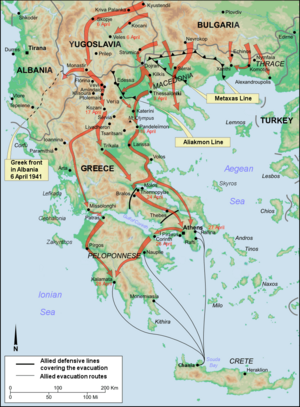 Nazi Germany's attack on Greece. |
|||||||
|
|||||||
| Combatants | |||||||
|
|||||||
| Commanders | |||||||
| Strength | |||||||
| Germany:[1] 680,000 men, 1200 tanks 700 aircraft 1Italy:[2] 565,000 men |
1Greece: 430,000 men British Commonwealth:[3] 262,612 men 100 tanks 200-300 aircraft |
||||||
| Casualties | |||||||
| 1Italy:[4] 13,755 dead, 63,142 wounded, 25,067 missing 1Germany:[5] 1,099 dead, 3,752 wounded, 385 missing |
1Greece:[4] 13,325 dead, 62,663 wounded, 1,290 missing British Commonwealth:[3] 903 dead, 1,250 wounded, 13,958 captured |
||||||
| 1Statistics about the strength and casualties of Italy and Greece refer to both the Greco-Italian War and the Battle of Greece (at least 300,000 Greek soldiers fought in Albania[6]). Statistics about Germany's casualties refer to the Balkans Campaign as a whole, and are based on Hitler's statements to the Reichstag on May 4, 1941.[7] 2Including Cypriots and Palestinians. British, Australian and New Zealand troops were approximately 58,000.[3] |
|||||||
The Battle of Greece (also known as Operation Marita, German: Unternehmen Marita) was a World War II battle that occurred on the Greek mainland and in southern Albania. The battle was fought between the Allied (Greece and the British Commonwealth) and Axis (Nazi Germany, Fascist Italy and Bulgaria) forces.
In March 1941, a major Italian counterattack failed, and Germany was forced to come to the aid of its ally. Operation Marita began on April 6, 1941, with German troops invading Greece through Bulgaria in an effort to secure its southern flank. The combined Greek and British Commonwealth forces fought back with great tenacity, but were vastly outnumbered and outgunned, and finally collapsed. Athens fell on April 27. However, the British managed to evacuate about 50,000 troops. The Greek campaign ended in a quick and complete German victory with the fall of Kalamata in the Peloponnese; it was over within 24 days. Nevertheless, both German and Allied officials have expressed their admiration for the strong resistance of the Greek soldiers.
Some historians regard the German campaign in Greece as decisive in determining the course of World War II, maintaining that it fatally delayed the Axis invasion of the Soviet Union. Others hold that the campaign had no influence on the launching of Operation Barbarossa, and characterize British intervention in Greece as a hopeless undertaking, a "political and sentimental decision" or even a "definite strategic blunder."
Prelude
Greco-Italian War
| “ | Hitler always faces me with a fait accompli. This time I am going to pay him back in his own coin. He will find out from the papers that I have occupied Greece.[8] |
” |
—Benito Mussolini speaking to Count Ciano |
||
At the outbreak of World War II, Ioannis Metaxas, the Prime Minister of Greece, sought to maintain a position of neutrality. However, Greece was increasingly subject to pressures from Italy, which culminated in the Italian submarine Delfino's torpedoing of the Greek cruiser Elli on August 15, 1940.[9] Benito Mussolini was irritated that Nazi leader Adolf Hitler had not consulted with him on his war policy, and wished to establish his independence,a[›] and to match the military success of the Germans through a victorious attack on Greece, a country he regarded as an easy opponent.[10] On October 15, 1940, Mussolini and his closest advisers decided to invade Greece.b[›] In the early hours of October 28, Italian Ambassador Emmanuel Grazzi presented Metaxas with a three-hour ultimatum, in which he demanded free passage for troops to occupy unspecified "strategic sites" within Greek territory.[11] Metaxas rejected the ultimatum (the refusal is commemorated as Okhi Day, a national holiday in Greece), but even before its expiration, Italian troops had invaded Greece through Albania.c[›] The principal Italian thrust was directed at Pindus, near the city of Ioannina, and initially made progress. The Italians then crossed the Thyamis (Kalamas) river, but were driven back and pursued into Albania.[12] Within three weeks, Greek territory was clear of the invaders, and a successful counterattack was underway. A number of towns of South Albania fell to Greek forces, and neither a change in Italian commanders, nor the arrival of a substantial number of reinforcements had much effect.[13]

|
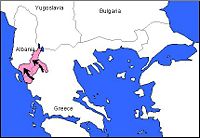
|
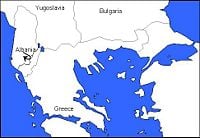
|
The Battle of Greece is generally regarded as a continuation of the Greco-Italian War, which began when Italian troops invaded Greece on October 28, 1940. Within weeks the Italians were driven from Greece and Greek forces pushed on to occupy much of southern Albania. After weeks of inconclusive winter warfare, the Italians launched a full-scale counterattack across the entire front on March 9, 1941, which, despite the superiority of the Italian armed forces, failed. After one week and 12,000 casualties, Mussolini called off the counterattack, and left Albania 12 days later.[14] Modern analysts believe that the Italian campaign failed because Mussolini and his generals initially allocated meager military resources to the campaign (an expeditionary force of 55,000 men),[15] failed to reckon with the autumn weather, and launched an attack without the advantage of surprise and without the support of the Bulgarians.[16] Even elementary precautions, such as the issue of winter clothing had not been taken.[17] Nor had Mussolini taken into consideration the recommendations of the Italian Commission of War Production, which had warned that Italy would not be able to sustain a full year of continuous warfare until 1949.[18]
During the six-month fight against Italy, the Greek army made local gains by eliminating enemy salients. Nevertheless, Greece did not have a substantial armaments industry, and both its equipment and ammunition supplies increasingly relied on stocks captured by British forces from defeated Italian armies in North Africa. In order to feed the battle in Albania, the Greek command was forced to make withdrawals from Eastern Macedonia and Western Thrace. Anticipation of a German attack expedited the need to reverse the position; the available forces were proving unable to sustain resistance on both fronts. The Greek command decided to support its success in Albania, regardless of how the situation might develop under the impact of a German attack from the Bulgarian border.[19]
Hitler's decision to attack and British aid to Greece
| "I wanted, above all to ask you to postpone the operation until a more favorable season, in any case until after the presidential election in America. In any event I wanted to ask you not to undertake this action without previously carrying out a blitzkrieg operation on Crete. For this purpose I intended to make practical suggestions regarding the employment of a parachute and of an airborne division." |
| From a letter Adolf Hitler addressed to Mussolini on November 20, 1940[20] |
Hitler intervened on November 4, 1940, four days after the British took both Crete and Lemnos. The Führer ordered his Army General Staff to prepare for an invasion of Northern Greece via Romania and Bulgaria. His plans for this campaign were incorporated into a master plan aimed at depriving the British of their Mediterranean bases.[21] On November 12, the German Armed Forces High Command issued Directive No. 18, in which they scheduled simultaneous operations against Gibraltar and Greece for the following January. However, in December 1940, German ambition in the Mediterranean underwent considerable revision when Spain's General Francisco Franco rejected plans for an attack on Gibraltar. Consequently, Germany's offensive in Southern Europe was restricted to the campaign against Greece. The Armed Forces High Command issued Directive No. 20 on December 13, 1940. The document outlined the Greek campaign under the code designation "Operation Marita," and planned for German occupation of the northern coast of the Aegean Sea by March, 1941. It also planned for the seizure of the entire Greek mainland, if that became necessary.[21][22] During a hastily called meeting of Hitler's staff after the unexpected March 27 coup d'état against the Yugoslav government, orders for the future campaign in Yugoslavia were drafted, as well as changes to the plan for the attack on Greece. On April 6, both Greece and Yugoslavia were to be attacked.[23]
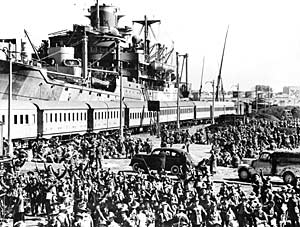
Britain was bound to assist Greece by the declaration of 1939, which stated that in the event of a threat to Greek or Romanian independence, "His Majesty's Government would feel themselves bound at once to lend the Greek or Romanian Government […] all the support in their power."[24] The first British effort was the deployment of RAF squadrons commanded by John d'Albiac, which were sent in November 1940.[25] With the consent of the Greek government, British forces were dispatched to Crete on October 31 to guard Suda Bay, enabling the Greek government to redeploy the 5th Cretan Division to the mainland.[26]
On November 17, 1940, Metaxas proposed to the British government the undertaking of a joint offensive in the Balkans with the Greek strongholds in South Albania as the base of the operations. The British side however was reluctant to discuss Metaxas' proposal, because the deployment of the troops the implementation of the Greek plan demanded would seriously endanger the Commonwealth military operations in North Africa.[27] During a meeting of British and Greek military and political leaders in Athens on January 13, 1941 General Alexandros Papagos, Commander-in-Chief of the Hellenic Army, asked Britain for nine fully-equipped divisions and corresponding air support. The British responded that, because of their commitment to the fight in North Africa, all they could offer was the immediate dispatch of a small token force of less than divisional strength. This offer was rejected by the Greeks who feared that the arrival of such a contingent would precipitate a German attack without giving them any sizable assistance.d[›] British help would be requested if and when German troops crossed the Danube from Romania into Bulgaria.[28][29]
| "We did not then know that he [Hitler] was already deeply set upon his gigantic invasion of Russia. If we had we should have felt more confidence in the success of our policy. We should have seen that he risked falling between two stools, and might easily impair his supreme undertaking for the sake of a Balkan preliminary. This is what actually happened, but we could not know that at the time. Some may think we builded rightly; at least we builded better than we knew at the time. It was our aim to animate and combine Yugoslavia, Greece, and Turkey. Our duty so far as possible was to aid the Greeks." |
| Winston Churchill[30] |
Winston Churchill held to his ambition to recreate a Balkan Front comprising Yugoslavia, Greece and Turkey,[30] and ordered Anthony Eden and Sir John Dill to resume negotiations with the Greek government. A meeting attended by Eden and the Greek leadership, including King George II, Prime Minister Alexandros Koryzis—the successor of Metaxas, who had died on January 29, 1941,—and Papagos took place in Athens on February 22. There the decision to send a British Commonwealth expeditionary force was made.[31] German troops had been massing in Romania and on March 1, 1941, Wehrmacht forces began to move into Bulgaria. At the same time, the Bulgarian Army mobilized and took up positions along the Greek frontier.[30] On March 2 Operation Lustre, the transportation of troops and equipment to Greece, began and 26 troopships arrived at the port of Piraeus.[32]On April 3, during a meeting of British, Yugoslav, and Greek military representatives, the Yugoslavs promised to block the Strimon valley in case of a German attack across their territory.[33] During this meeting, Papagos laid stress on the importance of a joint Greco-Yugoslavian offensive against the Italians, as soon as the Germans launched their offensive against the two countries.e[›] Until April 24, more than 62,000 Commonwealth troops (British, Australians, New Zealanders, Palestinians and Cypriots) were sent to Greece, comprising the 6th Australian Division, the New Zealand 2nd Division, and the British 1st Armoured Brigade. The three formations later became known as 'W' Force, after their commander, Lieutenant-General Sir Henry Maitland Wilson.f[›]
Military preparations
Strategic factors
The mountainous terrain of Greece favored a defensive strategy, and the high ranges of the Rhodope, Epirus, Pindus, and Olympus mountains offered many opportunities to stop an invader. However, adequate air power was required to prevent defending ground forces from becoming trapped in the many defiles. Although an invading force from Albania can be stopped by a relatively small number of troops positioned in the high Pindus mountains, the northeastern part of the country was difficult to defend against an attack from the north.[34]
Following a conference in Athens that March, the British command believed that they would combine with Greek forces to occupy the Haliacmon Line—a short front facing northeastward along the Vermion Mountains, and the lower Haliacmon river. Papagos awaited clarification from the Yugoslav government, and later proposed to hold the Metaxas Line—by then a symbol of national security to the Greek populace—and not withdraw any of his divisions from Albania.[35] He argued that to do so would be seen as a concession of victory to the Italians. The strategically important port of Thessaloniki lay practically indefensible, and transportation of British troops to the city remained dangerous.[36] Papagos proposed to take advantage of the area's difficult terrain and prepare fortifications, while at the same time protecting Thessaloniki.
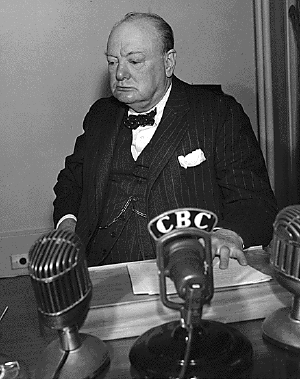
General Dill described Papagos' attitude as "unaccommodating and defeatist,"[38] arguing that his plan disregarded the fact that Greek troops and artillery were capable of only token resistance. The British believed that the Greek rivalry with Bulgaria—the Metaxas Line was designed specifically for use in the event of war with Bulgaria—as well as their traditionally good terms with the Yugoslavs, left their north-western border largely undefended.[39] Despite their concerns over the vulnerability of the border system, and their awareness that it was likely to collapse in the event of a German thrust from the Strimon and Axios rivers, the British eventually conceded to the Greek command. On March 4, Dill accepted the plans for the Metaxas line, and on March 7, agreement was ratified by the British Cabinet.[40] The overall command was to be retained by Papagos, and the Greek and British commands resigned themselves to fighting a delaying action in the northeastern part of the country.[34] Nevertheless, the British did not move their troops, because General Wilson regarded them as too weak to maintain such a broad front line. Instead, he took a position some 40 miles west of the Axios, across the Haliacmon Line.[41] The two main objectives in establishing this position were to maintain contact with the Greek First Army in Albania, and to deny German access to Central Greece. This had the advantage of requiring a smaller force than other options, while still allowing more time for preparation. However, it meant abandoning nearly the whole of Northern Greece, and was thus unacceptable to the Greeks for both political and psychological reasons. Moreover, the left flank of the line was susceptible to flanking from Germans operating through the Monastir gap in Yugoslavia.[42] However, the possibility of a rapid disintegration of the Yugoslav Army, and a German thrust into the rear of the Vermion position, was not taken into consideration.[34]
The German strategy was based on utilization of the blitzkrieg tactics which had proved successful during the invasions of Western Europe, and confirmed their effectiveness during the invasion of Yugoslavia. The German command planned to couple an attack of ground troops and tanks with support from the air, and make a rapid thrust into the territory. Once Thessaloniki was captured, Athens and the port of Piraeus would be the next principal targets. With Piraeus and the Isthmus of Corinth in German hands, the withdrawal and evacuation of British and Greek forces would be fatally compromised.[34]
Defense and attack forces
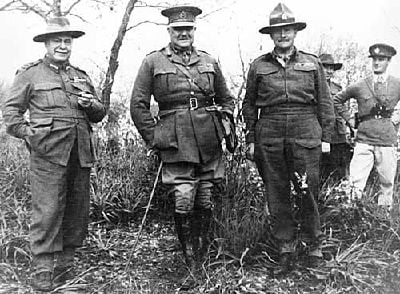
The Fifth Yugoslav Army was given responsibility for the defense of the southeastern border between Kriva Palanka and the Greek border. At the time of the German attack, the Yugoslav troops were not yet fully mobilized, and lacked a sufficient amount of modern equipment or weapons to be fully effective. Following the entry of German forces into Bulgaria, the majority of Greek troops were evacuated from Western Thrace. By this time, the total strength of the Greek forces defending the Bulgarian border totaled roughly 70,000 men, under the command of the Greek Second Army. The remainder of the Greek forces—the First Army, composed of 14 divisions—was committed in Albania.[43]
On March 28, the Greek forces in Central Macedonia—the 12th and 20th Infantry Divisions—were put under the command of General Wilson, who established his headquarters northwest of Larissa. The New Zealand division took a position north of Mount Olympus, while the Australian division blocked the Haliacmon valley up to the Vermion range. The Royal Air Force continued to operate from airfields in Central and Southern Greece; however, few planes could be diverted to the theater. The British forces were near to fully motorized, but their equipment was more suited to desert warfare than to the steep mountain roads of Greece. There was a shortage of tanks and anti-aircraft guns, and the lines of communication across the Mediterranean were vulnerable, because each convoy had to pass close to enemy-held islands in the Aegean; despite the fact that the British Navy dominated the Aegean Sea. These logistical problems were aggravated by the limited availability of shipping and capacity of the Greek ports.[44]
The German Twelfth Army, under the command of Field Marshal Wilhelm List, was charged with the execution of Operation Marita. His army was composed of six units:
- First Panzer Group, under the command of General Ewald von Kleist.
- XL Panzer Corps, under Lieutenant General Georg Stumme.
- XVIII Mountain Corps, under Lieutenant General Franz Böhme.
- XXX Infantry Corps, under Lieutenant General Otto Hartmann.
- L Infantry Corps, under Lieutenant General Georg Lindemann.
- 16th Panzer Division, deployed behind the Turkish-Bulgarian border to support the Bulgarian forces in case of a Turkish attack.[45]
German plan of attack and assembly
The German plan of attack was informed by their army's experiences during the Battle of France. Their strategy was to create a diversion through the campaign in Albania, thus stripping the Greek Army of sufficient manpower for the defense of their Yugoslavian and Bulgarian borders. By driving armored wedges through the weakest links of the defense chain, the ability to penetrate into enemy territory would be more easily achieved, and would not necessitate the maneuver of their armor behind an infantry advance. Once the weak defense system of Southern Yugoslavia were overrun by German armor, the Metaxas Line could be outflanked by highly mobile forces thrusting southward from Yugoslavia. Thus possession of Monastir and the Axios valley leading to Thessaloniki became essential for such an outflanking maneuver.[46]
The Yugoslav coup d'état led to a sudden change in the plan of attack, and confronted the Twelfth Army with a number of difficult problems. According to the March 28 Directive No. 25, the Twelfth Army was to regroup its forces in such a manner that a mobile task force would be available to attack via Niš toward Belgrade. With only nine days left before D-Day, every hour became valuable, and each fresh assembly of troops would need time to mobilize. By the evening of April 5, each attack force intended to enter either Southern Yugoslavia or Greece had been assembled.[47]
German invasion
Thrust across Southern Yugoslavia and drive to Thessaloniki
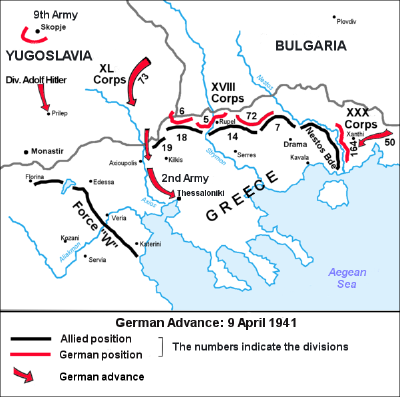
On the dawn of April 6, the German armies invaded Greece, while the Luftwaffe began an intensive bombardment of Belgrade. The XL Panzer Corps—which had been intended for use in an attack across southern Yugoslavia—began their assault at 05:30A.M., and made thrusts across the Bulgarian frontier at two separate points. By the evening of April 8, the 1st SS Division Adolf Hitler captured Prilep, thus severing an important rail line between Belgrade and Thessaloniki, and isolating Yugoslavia from its allies. The Germans were now in possession of terrain which was favorable to the continuation of the offensive. On the evening of April 9, General Stumme deployed his forces north of Monastir, in preparation for the extension of the attack across the Greek border toward Florina. This position threatened to encircle the Greeks in Albania and W Force in the area of Florina, Edessa, and Katerini.[48] While weak security detachments covered the rear of his corps against a surprise attack from central Yugoslavia, elements of the 9th Panzer Division drove westward to link up with the Italians at the Albanian border.[49]
The 2nd Panzer Division (XVIII Mountain troops) entered Yugoslavia from the east on the morning of April 6, and advanced westward through the Strimon Valley. It encountered little enemy resistance, but was delayed by road clearance demolitions, land mines, and muddy roads. Nevertheless, the division was able to reach the objective of the day, the town of Strumica. On April 7, a Yugoslav counter attack against the northern flank of the division was repelled, and the following day the division forced its way across the mountains and overran the Greek 19th Motorized Infantry Division Units stationed south of Doiran lake. Despite many delays along the narrow mountain roads, an armored advance guard dispatched in the direction of Thessaloniki succeeded in entering the city by the morning of April 9. The seizure of Thessaloniki took place without struggle, following the collapse of the Greek Second Army.[50]
Metaxas Line
The Metaxas Line was defended by the Eastern Macedonia Army Section, which comprised the 7th, 14th and 17th Infantry Divisions under the command of Lieutenant General Konstantinos Bakopoulos. The line ran for about 170 km along the river Nestos to the east, and then to the east following the Bulgarian border as far as Mount Beles near the Yugoslav border. The fortifications were designed to garrison an army of over 200,000 troops, but due to a lack of available manpower, the actual number was roughly 70,000. As a result of the low numbers, the line's defenses were thinly spread.[51]
The initial German attacks against the line were undertaken by a single German infantry unit reinforced by two mountain divisions of the XVIII Mountain Corps. These first forces encountered strong resistance, and had limited success.[52] A German report at the end of the first day described how the German 5th Mountain Division "was repulsed in the Rupel Pass despite strongest air support and sustained considerable casualties."[53] Of the 24 forts which made up the Metaxas Line, only two had fallen, and then only after they had been destroyed.[54]
The line was penetrated following a three-day struggle during which the Germans pummeled the forts with artillery and dive bombers. The main credit for this achievement must be given to the 6th Mountain Division, which crossed a 7,000-foot (2,100 m) snow-covered mountain range and broke through at a point that had been considered inaccessible by the Greeks. The force reached the rail line to Thessaloniki on the evening of April 7. The other XVIII Mountain Corps units advanced step by step under great hardship. The 5th Division, together with the reinforced 125th Infantry Regiment, penetrated the Strimon defenses on April 7, and attacked along both banks of the river, clearing one bunker after another as they passed. Nevertheless the unit suffered heavy casualties, to the extent that it was withdrawn from further action after it had reached its objective location. The 72d Infantry Division advanced from Nevrokop across the mountains, and, although it was handicapped by a shortage of pack animals, medium artillery, and mountain equipment, it managed to break through the Metaxas Line on the evening of April 9, when it reached the area northeast of Serres.[55] Even after General Bakopoulos surrendered the Metaxas Line, isolated fortresses held out for days, and were not taken until heavy artillery was utilized against them. Some field troops and soldiers manning the frontier continued to fight on, and as a result a number were able to evacuate by sea.[56]
Capitulation of the Greek Second Army
The XXX Infantry Corps on the left wing reached its designated objective on the evening of April 8, when the 164th Infantry Division captured Xanthi. The 50th Infantry Division advanced far beyond Komotini towards the Nestos river, which both divisions reached on the next day. On April 9, the Greek Second Army capitulated unconditionally following the collapse of Greek resistance east of the Axios river. In an April 9 estimate of the situation, Field Marshal List expressed the opinion that as a result of the swift advance of the mobile units, his 12th Army was now in a favorable position to gain access to Central Greece by breaking the enemy buildup behind the Axios river. On the basis of this estimate List requested the transfer of the 5th Panzer Division from First Panzer Group to the XL Panzer Corps. He reasoned that its presence would give additional punch to the German thrust through the Monastir gap. For the continuation of the campaign he formed two attack groups, an eastern one under the command of XVIII Mountain Corps, and a western group led by XL Panzer Corps.[57]
Breakthrough to Kozani
By the morning of April 10, the XL Panzer Corps had finished its preparations for the continuation of the offensive, and continued the advance in the direction of Kozani. Against all expectations, the Monastir gap had been left open, and the Germans exploited their chance. First contact with Allied troops was made north of Vevi at 11:00A.M. on April 10. SS troops seized Vevi on April 11, but were stopped at the Klidi Pass just south of the town, where a mixed Commonwealth-Greek formation, known as Mackay Force, was assembled to. During the next day the SS regiment reconnoitered the enemy positions, and at dusk launched a frontal attack against the pass. Following heavy fighting, the Germans overcame the enemy resistance, and broke through the defense.[58] By the morning of April 14, the spearheads of the 9th Panzer Division reached Kozani.
Olympus and Servia passes
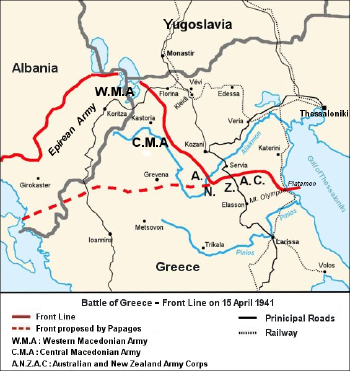
Wilson faced the prospect of being pinned by Germans operating from Thessaloniki, while being flanked by the German XL Panzer Corps descending through the Monastir Gap. On April 13, he decided to withdraw all British forces to the Haliacmon river, and then to the narrow pass at Thermopylae.[59] On April 14 the 9th Panzer Division established a bridgehead across the Haliacmon river, but an attempt to advance beyond this point was stopped by intense enemy fire. This defense had three main components: the Platamon tunnel area between Olympus and the sea, the Olympus pass itself, and the Servia pass to the southeast. By channeling the attack through these three defiles, the new line offered far greater defensive strength for the limited forces available. The defenses of the Olympus and Servia passes consisted of the 4th New Zealand Brigade, 5th New Zealand Brigade, and the 16th Australian Brigade. For the next three days the advance of the 9th Panzer Division was stalled in front of these resolutely held positions.[60]
A ruined castle dominated the ridge across which the coastal pass led to Platamon. During the night of April 15 a German motorcycle battalion supported by a tank battalion attacked the ridge, but the Germans were repulsed by the 21st New Zealand Battalion under Colonel Macky, which suffered heavy losses in the process. Later that day a German armored regiment arrived and struck the coastal and inland flanks of the battalion, but the New Zealanders held their ground. After being reinforced during the night of the 15th-16th, the Germans managed to assemble a tank battalion, infantry battalion, and motor cycle battalion. The German infantry attacked the New Zealanders' left company at dawn, while the tanks attacked along the coast several hours later.[61]
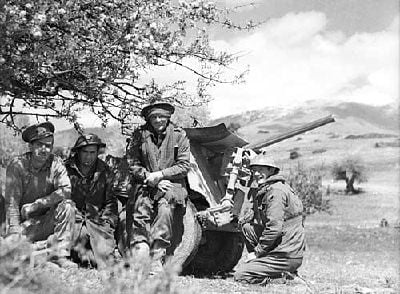
The New Zealand battalion withdrew, crossed the Pineios river, and by dusk reached the western exit of the Pineios Gorge, suffering only light casualties.[61] Macky was informed that it was "essential to deny the gorge to the enemy till April 19 even if it meant extinction."[62] He sank the crossing barge at the western end of the gorge once all his men were across and began to set up defenses. The 21st battalion was reinforced by the Australian 2/2nd Battalion and later by the 2/3rd, this force became known as Allen force after Brigadier "Tubby" Allen. The 2/5th and 2/11th battalions moved to the Elatia area south-west of the gorge and were ordered to hold the western exit possibly for three or four days.
On April 16 General Wilson met General Papagos at Lamia and informed him of his decision to withdraw to Thermopylae. General Blamey divided responsibility between generals Mackay and Freyberg during the leapfrogging move back to Thermopylae. Mackay would protect the flanks of the New Zealand Division as far south as an east-west line through Larissa and would control the withdrawal through Domokos to Thermopylae of the Savige and Zarkos Forces, and finally of Lee Force; the 1st Armored Brigade would cover the withdrawal of Savige Force to Larissa and thereafter the withdrawal of the 6th Division under whose command it would come; Freyberg would control the withdrawal of Allen Force which was to move along the same route as the New Zealand Division. The British Commonwealth forces remained under constant attack throughout the entire withdrawal.
On the morning of April 18 the struggle for the Pineios gorge was over, when German armored infantry crossed the river on floats and the 6th Mountain Division troops worked their way around the New Zealand battalion, which was subsequently annihilated. On April 19 the first XVIII Mountain Corps troops entered Larissa and took possession of the airfield, where the British had left their supply dumps intact. The seizure of ten truckloads of rations and fuel enabled the spearhead units to continue their drive without ceasing. The port of Volos, at which the British had re-embarked numerous units during the last few days, fell on April 21; there, the Germans captured large quantities of valuable diesel and crude oil.[63]
Withdrawal and surrender of the Greek First Army
As the invading Germans advanced deep into Greek territory, the Greek First Army operating in Albania was reluctant to retreat. General Wilson described this unwillingness as "the fetishistic doctrine that not a yard of ground should be yielded to the Italians."[64] It was not until April 13 that the first Greek elements began to withdraw toward the Pindus mountains. The Allies' retreat to Thermopylae uncovered a route across the Pindus mountains by which the Germans might flank the Greek army in a rearguard action. An SS regiment was given the mission of cutting off the Greek First Army's line of retreat from Albania by driving westward to the Metsovon pass, and from there to Ioannina.[65] On April 14, heavy fighting took place at Kastoria pass, where the Germans blocked the Greek withdrawal. The withdrawal extended across the entire Albanian front, with the Italians in hesitant pursuit.[66]
General Papagos rushed Greek units to the Metsovon pass where the Germans were expected to attack. On April 18, a pitched battle between several Greek units and the Leibstandarte SS Adolf Hitler brigade—which had by then reached Grevena—erupted.[66] The Greek units lacked the equipment necessary to fight against a motorized unit and were soon encircled and overwhelmed. The Germans advanced further and on April 19 captured Ioannina, the final supply route of the Greek First Army. Allied newspapers dubbed the Greek army's fate as a modern day Greek tragedy. Historian and former war-correspondent, Christopher Buckley, when describing the fate of the Greek army, states that "one experience[d] a genuine Aristotelian catharsis, an awe-inspiring sense of the futility of all human effort and all human courage."[67]
On April 20, the commander of the Greek forces in Albania, General Georgios Tsolakoglou, realized the hopelessness of the situation and offered to surrender his army, which then consisted of 14 divisions.[66] World War II historian John Keegan writes that Tsolakoglou "was so determined […] to deny the Italians the satisfaction of a victory they had not earned that […] he opened quite unauthorized parley with the commander of the German SS division opposite him, Sepp Dietrich, to arrange a surrender to the Germans alone."[68] On strict orders from Hitler negotiations were kept secret from the Italians, and the surrender was accepted.[66] Outraged by this decision Mussolini ordered counterattacks against the Greek forces, which were repulsed. It took personal representation from Mussolini to Hitler to bring together an armistice in which Italy was included on April 23.[69] Greek soldiers were not treated as prisoners of war, and were allowed instead to go home after the demobilization of their units, while their officers were permitted to retain their side arms.[70]
Thermopylae position
As early as April 16, the German command realized that the British were evacuating troops on ships at Volos and Piraeus. The whole campaign had taken on the character of a pursuit. For the Germans it was now primarily a question of maintaining contact with the retreating British forces, and foiling their evacuation plans. German infantry divisions were withdrawn from action due to a lack of mobility. The 2nd and 5th Panzer Divisions, the 1st SS Motorized Infantry Regiment, and both mountain divisions launched a pursuit on enemy forces.[71]
To allow an evacuation of the main body of British forces, Wilson ordered the rear guard to make a last stand at the historic Thermopylae pass, the gateway to Athens. General Freyberg was given the task of defending the coastal pass, while Mackay was to hold the village of Brallos. After the battle Mackay was quoted as saying "I did not dream of evacuation; I thought that we'd hang on for about a fortnight and be beaten by weight of numbers."[72] When the order to retreat was received on the morning of April 23 it was decided that each of the two positions was to be held by one brigade each. These brigades, the Australian 19th and 6th New Zealand were to hold the passes as long as possible, allowing the other units to withdraw. The Germans attacked on April 24 at 11:30A.M., met fierce resistance, lost 15 tanks and sustained considerable casualties. The Allies held out the entire day; with the delaying action accomplished, they retreated in the direction of the evacuation beaches and set up another rearguard at Thebes.[73] The Panzer units launching a pursuit along the road leading across the pass made slow progress because of the steep gradient and a large number of difficult hairpin bends.[74]
German drive on Athens
| "The quarrel over the troops' victorious entry into Athens was a chapter to itself: Hitler wanted to do without a special parade, to avoid injuring Greek national pride. Mussolini, alas, insisted on a glorious entry into the city for his Italian troops. The Führer yielded to the Italian demand and together the German and Italian troops marched into Athens. This miserable spectacle, laid on by our gallant ally whom they had honorably beaten, must have produced some hollow laughter from the Greeks." |
| Wilhelm Keitel[75] |
After abandoning the Thermopylae area, the British rear guards withdrew to an improvised switch position south of Thebes, where they erected a last obstacle in front of Athens. The motorcycle battalion of the 2nd Panzer Division, which had crossed to the island of Euboea to seize the port of Chalcis, and had subsequently returned to the mainland, was given the mission of outflanking the British rear guard. The motorcycle troops encountered only slight resistance, and on the morning of April 27, 1941, the first Germans entered Athens, followed by armored cars, tanks, and infantry. They captured intact large quantities of POL (petroleum, oil and lubricants) several thousand tons of ammunition, ten trucks loaded with sugar and ten truckloads of other rations in addition to various other equipment, weapons, and medical supplies.[76]
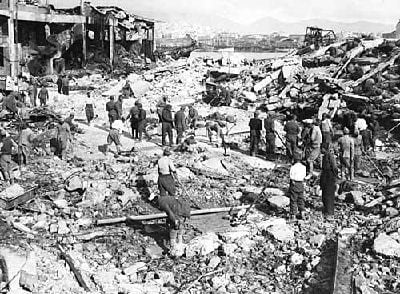
Evacuation of Commonwealth forces
Little news from Greece, but 13,000 men got away to Crete on Friday night, and so there are hopes of a decent percentage of evacuation. It is a terrible anxiety […] War Cabinet. Winston says "We will lose only 5,000 in Greece." We will in fact lose at least 15,000. W. is a great man, but he is more addicted to wishful thinking every day.[77]
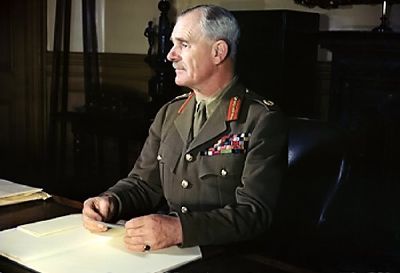
General Archibald Wavell, the commander of British Army forces in the Middle East, when in Greece on April 11–13, had warned Wilson that he must expect no reinforcements, and had authorized Major General Freddie de Guingand to discuss evacuation plans with certain responsible officers. Nevertheless, the British could not at this stage adopt or even mention this course of action; the suggestion had to come from the Greek Government. The following day Papagos made the first move when he suggested to Wilson that W Force should be withdrawn. Wilson informed Middle East Headquarters and on April 17 Rear admiral H. T. Baillie-Grohman was sent to Greece to prepare for the evacuation.[79] That day Wilson hastened to Athens where he attended a conference with the King, Papagos, d'Albiac and Rear admiral Turle. In the evening, Koryzis after telling the King that he felt he had failed him in the task entrusted to him, committed suicide. On April 21 the final decision for the evacuation of the Commonwealth forces to Crete and Egypt was taken, and Wavell, in confirmation of verbal instructions, sent his written orders to Wilson.[80]
On the night of April 24, 5200 men, most of which belonged to the 5th New Zealand Brigade, were evacuated from Porto Rafti of East Attica, while the 4th New Zealand Brigade remained to block the narrow road to Athens, which was dubbed the 24 Hour Pass by the New Zealanders.[81] On April 25 (Anzac Day), the few RAF squadrons left Greece (d'Albiac established his headquarters in Heraklion, Crete), and some 10,200 Australian troops were evacuated from Nauplion and Megara.[82] 2000 more men had to wait until April 27, because Ulster Prince ran aground in shallow waters close to Nauplion. Because of this event, the Germans realized that the evacuation was also taking place from the ports of East Peloponnese.[83]
| "We cannot remain in Greece against wish of Greek Commander-in-Chief, and thus expose country to devastation. Wilson or Palairet should obtain endorsement by Greek Government of Papagos' request. Consequent upon this assent, evacuation should proceed, without however prejudicing any withdrawal to Thermopylae position in co-operation with the Greek Army. You will naturally try to save as much material as possible." |
| Winston Churchill's response to the Greek proposal on April 17, 1941[84] |
On April 25, the Germans staged an airborne operation to seize the bridges over the Corinth canal, with the double aim of both cutting off the British line of retreat and securing their own way across the isthmus. The attack met with initial success, until a stray British shell destroyed the bridge.[85] The 1st SS Motorized Infantry Regiment, assembled at Ioannina, thrust along the western foothills of the Pindus Mountains via Arta to Messolonghi, and crossed over to the Peloponnese at Patras in an effort to gain access to the isthmus from the west. Upon their arrival at 5:30P.M. on April 27 the SS forces learned that the paratroops had already been relieved by Army units advancing from Athens.[76]
The erection of a temporary span across the Corinth canal permitted 5th Panzer Division units to pursue the enemy forces across the Peloponnese. Driving via Argos to Kalamata, from where most Allied units had already begun to evacuate, they reached the south coast on April 29, where they were joined by SS troops arriving from Pyrgos.[76] The fighting on the Peloponnese consisted merely of small-scale engagements with isolated groups of British troops who had been unable to make ship in time. The attack came a few days too late to cut off the bulk of the British troops in Central Greece, but did manage to isolate the Australian 16th and 17th Brigades.[86] By April 30 the evacuation of about 50,000 soldiers was completed,g[›] but was heavily contested by the German Luftwaffe, which sank at least twenty-six troop-laden ships. The Germans captured around 7000–8000 Commonwealth (including 2000 Cypriots and Palestinians) and Yugoslav troops in Kalamata who had not been evacuated, while liberating many Italian prisoners from POW camps.[87]
Aftermath
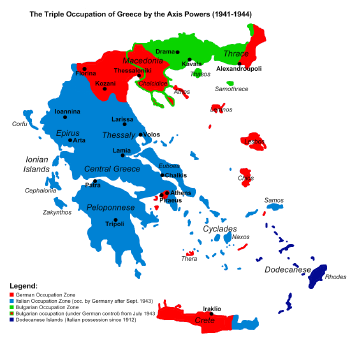 |
| The three occupation zones: Italian German Bulgarian |
Triple occupation
On April 13, 1941, Hitler issued his Directive No. 27, which illustrated his future occupying policy in Greece. He finalized jurisdiction in the Balkans with his Directive No. 31 issued on June 9. Mainland Greece was divided between Germany, Italy, and Bulgaria. German forces occupied the strategically more important areas, namely Athens, Thessaloniki with Central Macedonia, and several Aegean islands, including most of Crete. They also occupied Florina, which was claimed by both Italy and Bulgaria. On the same day that Tsolakoglou offered his surrender, the Bulgarian Army invaded Thrace. The goal was to gain an Aegean Sea outlet in Western Thrace and Eastern Macedonia. The Bulgarians occupied territory between the Strimon river and a line of demarcation running through Alexandroupoli and Svilengrad west of Evros river.[88] The remainder of Greece was left to Italy. Italian troops started occupying the Ionian and Aegean islands on April 28. On June 2 they occupied the Peloponnese, on June 8 Thessaly, and on June 12 most of Attica.
The occupation of Greece, during which civilians suffered terrible hardships, and died from privation and hunger, proved to be a difficult and costly task. It led to the creation of several resistance groups, which launched guerrilla attacks against the occupying forces and set up espionage networks.[89]
Battle of Crete
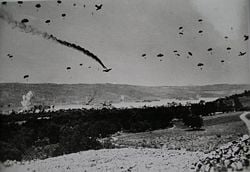 German paratroopers land in Crete. |
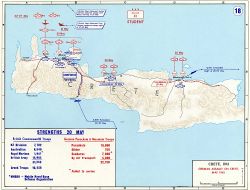 Map of the German assault on Crete. |
On April 25, 1941, King George II and his government left the Greek mainland for Crete, which was attacked by Nazi forces on May 20, 1941.[90] The Germans employed parachute forces in a massive airborne invasion, and launched their offensive against three main airfields of the island in Maleme, Rethymno, and Heraklion. After seven days of fighting and tough resistance, Allied commanders decided that the cause was hopeless, and ordered a withdrawal from Sfakia. By June 1, 1941, the evacuation of Crete by the Allies was complete and the island was under German occupation. In light of the heavy casualties suffered by the élite 7th Flieger Division, Hitler forbade further airborne operations.[91] German Luftwaffe Gen. Kurt Student would dub Crete "the graveyard of the German paratroopers" and a "disastrous victory."[91] During the night of May 24, George II and his government were evacuated from Crete to Egypt.[31]
Assessments
| Battle of Greece Timeline | |
|---|---|
| April 6, 1941 | The German armies invade Greece. |
| April 8, 1941 | The German 164th Infantry Division captures Xanthi. |
| April 9, 1941 | German troops seize Thessaloniki. The German 72d Infantry Division breaks through the Metaxas Line. The Greek Second Army capitulates unconditionally. |
| April 10, 1941 | The Germans overcome the enemy resistance north of Vevi, at the Klidi Pass. |
| April 13, 1941 | General Wilson decides to withdraw all British forces to the Haliacmon river, and then to Thermopylae. Elements of the Greek First Army operating in Albania withdraw toward the Pindus mountains. Hitler issues his Directive No. 27, which illustrates his future occupying policy in Greece. |
| April 14, 1941 | The spearheads of the 9th Panzer Division reach Kozani. After fighting at Kastoria pass, the Germans block the Greek withdrawal, which extends across the entire Albanian front. |
| April 16, 1941 | Wilson informs General Papagos of his decision to withdraw to Thermopylae. |
| April 17, 1941 | Rear admiral H. T. Baillie-Grohman is sent to Greece to prepare for the evacuation of the Commonwealth forces. |
| April 18, 1941 | After a three-days struggle, German armored infantry crosses the Pineios river. The 1st SS Division Leibstandarte SS Adolf Hitler—which had reached Grevena— overwhelms several Greek units. |
| April 19, 1941 | German troops enter Larissa and take possession of the airfield. German troops capture Ioannina. |
| April 20, 1941 | The commander of the Greek forces in Albania, General Georgios Tsolakoglou, offers to surrender his army to the Germans alone. The Bulgarian Army invades Thrace. |
| April 21, 1941 | The final decision for the evacuation of the Commonwealth forces to Crete and Egypt is taken. The Germans capture the port of Volos. |
| April 23, 1941 | Official surrender of the Greek forces in Albania to both the Germans and the Italians after a personal representation from Mussolini to Hitler |
| April 24, 1941 | The Germans attack the Commonwealth forces at Thermopylae. The British rear guards withdraw to Thebes. 5,200 Commonwealth soldiers are evacuated from Porto Rafti, East Attica. |
| April 25, 1941 | The few RAF squadrons leave Greece. Some 10,200 Australian troops are evacuated from Nauplion and Megara. The Germans stage an airborne operation to seize the bridges over the Corinth Canal. |
| April 27, 1941 | The first Germans enter Athens. |
| April 28, 1941 | Italian troops start occupying the Ionian and Aegean islands. |
| April 29, 1941 | 5th Panzer Division units reach the south coast of Peloponnese, where they are joined by SS troops arriving from Pyrgos. |
| April 30, 1941 | The evacuation of 42,311 Commonwealth soldiers is completed. The Germans manage to capture around 7-8,000 Commonwealth troops. |
The Greek campaign ended in a complete German victory. The British did not have the necessary military resources in the Middle East to permit them to carry out simultaneous Iarge-scale operations in North Africa and the Balkans. Moreover, even if they had been able to block the German advance into Greece, they would have been unable to exploit the situation by a counterthrust across the Balkans. However, the British came very near to holding on to Crete and originally must have had reasonable prospects of holding Crete and perhaps some other islands which would have been extremely valuable as airbases from which to support naval operations throughout the eastern Mediterranean.
Reasons for the complete German victory in Greece include:
- Germany's superiority in ground forces and equipment;[92]
- German supremacy in the air combined with the inability of the Greeks to provide the RAF with more airfields;[93]
- Inadequacy of the British expeditionary force, since the Imperial force available was small;[92]
- Poor condition of the Greek Army and its shortage of modern equipment;[93]
- Inadequate port, road and railway facilities;[94]
- Absence of a unified command and lack of cooperation between the British, Greek, and Yugoslav forces;[93]
- Turkey's strict neutrality;[93] and
- The early collapse of Yugoslav resistance.[93]
After the defeat of the Allies, the decision to send British forces into Greece was met with fierce criticism in the UK. Field Marshal Alan Brooke, Chief of the Imperial General Staff during World War II, considered intervention in Greece to be "a definite strategic blunder," as it denied Wavell the necessary reserves to complete the conquest of Italian-held Libya, or to successfully withstand Erwin Rommel's Afrika Korps March offensive. It thus prolonged the North African Campaign, which otherwise might have been successfully concluded within 1941.[95] In 1947 de Guingand asked the British government to recognize the mistakes it made when it laid out its strategy in Greece.[96] Christopher Buckley, on the other hand, argued that, if the UK had not answered its commitment of 1939 to defend Greece's independence, it would have severely damaged the ethical rationalizations of its struggle against Nazi Germany.[97] According to professor of history, Heinz Richter, Churchill tried through the campaign in Greece to influence the political atmosphere in the United States, and he insisted on this strategy even after the defeat.[98] According to John Keegan, "the Greek campaign had been an old-fashioned gentlemen's war, with honor given and accepted by brave adversaries on each side," and the Greek and Allied forces, being vastly outnumbered, "had, rightly, the sensation of having fought the good fight."[69] >
According to German filmmaker Leni Riefenstahl, Hitler said that "if the Italians hadn't attacked Greece and needed our help, the war would have taken a different course. We could have anticipated the Russian cold by weeks and conquered Leningrad and Moscow. There would have been no Stalingrad".[99] Despite his reservations, Brooke seems also to have conceded that the start of the German offensive against the Soviet Union was in fact delayed because of the Balkan Campaign.[95]
There were political consequences from this campaign for the population of Greece. Had the Greek government held onto some foothold in Greece, such as Crete, they might have maintained a greater degree of legitimacy in the eyes of the Greek population. Their lack of legitimacy could have been a precipitating factor for the civil war.
Citations
This, incidentally, disposes of the German assertion that they were forced to attack us only in order to expel the British from Greece, for they knew that, if they had not marched into Bulgaria, no British troops would have landed in Greece. Their assertion was merely an excuse on their part to enable them to plead extenuating circumstances in justification of their aggression against a small nation, already entangled in a war against a Great Power. But, irrespective of the presence or absence of British troops in the Balkans, German intervention would have taken place firstly because the Germans had to secure the right flank of the German Army which was to operate against Russia according to the plans already prepared in autumn 1940, and secondly because the possession of the southern part of the Balkan Peninsula commanding the eastern end of the Mediterranean was of great strategic importance for Germany's plan of attacking Great Britain and the line of Imperial communications with the East.[102]
Notes
- ↑ Richard Collier, Duce! (Viking Adult, 1971, ISBN 9780670286034), 180; "Greek Wars" in Encyclopaedia "The Helios".
- ↑ Heinz A. Richter, Greece in World War II, (translated from the German original by Kostas Sarropoulos). (in Greek). (Athens: Govostis, 1998), 119, 144.
- ↑ 3.0 3.1 3.2 Antony Beevor, Crete: The Battle and the Resistance (Boulder, CO: Westview Press, 1994, ISBN 0813320801), 26.
W.G. McClymont. To Greece: The Official History of New Zealand in the Second World War 1939–1945 (Wellington: Historical Publications Branch, 1959), 486 Retrieved March 15, 2021.
Richter, 595–597. - ↑ 4.0 4.1 Richter, 595–597.
- ↑ Rolf Bathe and Erich Glodschey, Der Kampf um den Balkan (in German) (Oldenburg, Berlin: Stalling-Glodschey, 1942), 246.
- ↑ "Greek Wars." Encyclopaedia "The Helios".
- ↑ Bathe and Glodschey, 246.
Richter, 595–597. - ↑ Galeazzo Ciano, The Ciano Diaries 1939–1943 (Doubleday & Company, 1946), 247.
Konstantinos Svolopoulos, The Greek Foreign Policy (in Greek) (Athens: Estia, 1997, ISBN 9600504326), 272. - ↑ "Greece, History of" in Encyclopaedia "The Helios"
- ↑ Christopher Buckley, Greece and Crete 1941 (Athens: P. Efstathiadis & Sons S.A., 1984, ISBN 9780117721937), 18.
Erik Goldstein, Wars and Peace Treaties (Routledge, 1992, ISBN 0415078229), 53. - ↑ 11.0 11.1 Buckley, 17.
- ↑ Southern Europe, World War-2.net. Retrieved March 15, 2021.
- ↑ Buckley, 18–20.
- ↑ Robert H. Bailey, Partisans and Guerrillas (World War II) (Time Life UK, 1979, ISBN 0809424908), 22.
- ↑ Richter, 119.
- ↑ Creveld, 1972, 41.
Davide Rodogno, Fascism's European Empire: Italian Occupation During the Second World War (Cambridge University Press, 2006, ISBN 9780521845151), 29–30. - ↑ Peter Neville, Mussolini (Routledge, 2003, ISBN 0415249899), 165.
- ↑ Stephen J. Lee, European Dictatorships, 1918–1945 (Routledge, 2000, ISBN 0415230454), 146.
- ↑ 19.0 19.1 George E. Blau, The German Campaigns in the Balkans (Spring 1941) (Burd Street Press, 1997, ISBN 978-1572490703), 70-72.
- ↑ Blau, 5.
- ↑ 21.0 21.1 Blau, 5–7.
"Greece, History of." The Helios - ↑ Svolopoulos, 288.
- ↑ McClymont, 158–159.
- ↑ Sheila Lawlor, Churchill and the Politics of War, 1940–1941 (Cambridge University Press, 1994, ISBN 0521466857), 167.
- ↑ M.B. Barrass, Air Marshal Sir John D'Albiac Air of Authority - A History of RAF Organisation. Retrieved March 15, 2021.
Beevor, 26. - ↑ Blau, 71–72.
Alan Vick, Snakes in the Eagle's Nest: A History of Ground Attacks on Air Bases (Rand Corporation, 1995, ISBN 0833016296), 22. - ↑ Svolopoulos, 285, 288.
- ↑ Beevor, 38.
- ↑ Blau, 71–72.
- ↑ 30.0 30.1 30.2 Winston Churchill, Memoirs of the Second World War (Houghton Mifflin Books, 1991, ISBN 0395599687), 420.
- ↑ 31.0 31.1 "George II." The Helios
- ↑ "Greece, History of" The Helios.
- ↑ Blau, 74.
- ↑ 34.0 34.1 34.2 34.3 Blau, 77.
- ↑ McClymont, 1959;
Alexandros Papagos, The Battle of Greece 1940–1941 (in Greek). (Athens: J.M. Scazikis Alpha, 1949), 115. - ↑ McClymont, 106–107.
- ↑ Lawlor, 191–192.
- ↑ Lawlor, 168.
- ↑ Bailey, 37.
- ↑ Lawlor, 168;
McClymont, 107–108. - ↑ Svolopoulos, 290.
- ↑ Buckley 40–45.
- ↑ Blau, 79.
- ↑ Blau, 79–80.
- ↑ Blau, 81.
- ↑ Blau, 82–83.
- ↑ Blau, 83–84.
- ↑ McClymont, 160.
- ↑ Blau, 86.
- ↑ Blau, 87.
- ↑ Buckley, 30–33.
- ↑ Buckley, 50;
Blau, 88. - ↑ Beevor, 33.
- ↑ Buckley, 50.
- ↑ Blau, 888.
- ↑ Buckley, 61;
Blau, 89. - ↑ Blau, 89–91.
- ↑ Blau, 91.
- ↑ Hondros, 52.
- ↑ Blau, 94.
- ↑ 61.0 61.1 Blau, 98.
- ↑ McClymont, 251.
- ↑ Blau, 100.
- ↑ Beevor, 39.
- ↑ Bailey, 32.
- ↑ 66.0 66.1 66.2 66.3 Blau, 94.
- ↑ Buckley, 113.
- ↑ John Keegan, The Second World War (Penguin, 2005, ISBN 0143035738), 157.
- ↑ 69.0 69.1 Keegan, 158.
- ↑ Blau, 94–96;
Hondros, 90. - ↑ Blau, 103.
- ↑ Ernest Wallace Christie, MC, RFA TheAuxilliaries.com. Retrieved March 15, 2021.
- ↑ Bailey, 33.
- ↑ Blau, 104.
- ↑ Keitel, 166.
- ↑ 76.0 76.1 76.2 Blau, 111.
- ↑ Robert Menzies, The Greek Campaign Menzies' 1941 Diary. Retrieved March 15, 2021.
- ↑ Michael Tyquin, Greece: February to April 1941 (Big Sky Publishing, 2016, ISBN 978-1922132611).
- ↑ McClymont, 362.
- ↑ McClymont, 366
Richter, 566–567, 580–581. - ↑ A. K. Macdougall, Australians at War: A Pictorial History (Scoresby, Victoria, AUS: The Five Mile Press, 2004, ISBN 1865038652), 194.
- ↑ Macdougall, 195;
Richter, 584–585. - ↑ Richter, 584.
- ↑ McClymont, 362–363.
- ↑ Blau, 108.
- ↑ Macdougall, 195.
- ↑ Blau, 112;
Richter, 595. - ↑ Richter, 616–617.
- ↑ Eric Carlton, Occupation: The Policies and Practices of Military Conquerors (Routledge, 1992, ISBN 0415058465), 136.
- ↑ "Crete, Battle of." The Helios
"George II." The Helios. - ↑ 91.0 91.1 Beevor, 231.
- ↑ 92.0 92.1 Blau, 116–118;
McClymont, 471–472. - ↑ 93.0 93.1 93.2 93.3 93.4 Blau, 116–118.
- ↑ McClymont, 471–472.
- ↑ 95.0 95.1 Charlie Lewis Broad, Winston Churchill: A Biography (Hawthorn Books, 1958), 113.
- ↑ Richter, 624.
- ↑ Buckley, 138.
- ↑ Richter, 633.
- ↑ Leni Riefenstahl, Leni Riefenstahl: A Memoir (New York: Picador, 1987, ISBN 0312119267), 295.
- ↑ Blau, 3–4.
- ↑ Blau, 3–4.
- ↑ Papagos, 317.
- ↑ "Greece, History of." The Helios
- ↑ Beevor, 60.
- ↑ Williamson Murray and Allan Reed Millett, "Diversions in the Mediterranean and Balkans," A War to Be Won: Fighting the Second World War (Cambridge, MA: Harvard University Press, 2000, ISBN 0674006801), 105.
- ↑ McClymont, 486.
- ↑ McClymont, 486.
References
ISBN links support NWE through referral fees
- Bailey, Robert H. Partisans and Guerrillas (World War II). Time Life UK, 1979. ISBN 0809424908
- Barber, Laurie, and John Tonkin-Covell. Freyberg: Churchill's Salamander. Hutchinson: Random House (NZ), 1990. ISBN 1869410521
- Bathe, Rolf, and Erich Glodschey. Der Kampf um den Balkan. (in German) Oldenburg, Berlin: Stalling, 1942. OCLC 1251437
- Beevor, Antony. Crete: The Battle and the Resistance. Boulder: Westview Press; Reissue ed. 1994. ISBN 0813320801
- Bitzes, John. Greece in World War II: To April 1941. Sunflower University Press, 1989. ISBN 0897450930
- Blau, George E. The German Campaigns in the Balkans (Spring 1941). Burd Street Press, 1997. ISBN 978-1572490703
- Bosworth, R.J.B. Mussolini. Oxford, UK: A. Hodder Arnold Publication, 2002. ISBN 0340731443
- Bradley, John N., and Thomas B. Buell. "Why Was Barbarossa Delayed?" in The Second World War: Europe and the Mediterranean (The West Point Military History Series). Garden City Park, NY: Square One Publishers, Inc., 2002. ISBN 0757001602
- "Brallos Pass" in The Encyclopaedia of Australia's Battles. Allen & Unwin, 2001. ISBN 9781865086347
- Broad, Charlie Lewis. Winston Churchill: A Biography. Hawthorn Books, 1958. OCLC 254082
- Buckley, Christopher. Greece and Crete 1941. (original 1952) republished Athens: P. Efstathiadis & Sons S.A., 1984. ISBN 9780117721937
- "Campaign in Greece" in The Encyclopedia Americana 2000. Grolier. ISBN 978-0717201228
- Carlton, Eric. Occupation: The Policies and Practices of Military Conquerors. Routledge, 1992. ISBN 0415058465
- Churchill, Winston. Winston Churchill: His Complete Speeches, 1897–1963, editor Robert Rhodes James. Chelsea House Publishers, 1974. ISBN 0835206939
- Ciano, Galeazzo. The Ciano Diaries 1939–1943. Doubleday & Company, 1946. OCLC 245645
- Collier, Richard. Duce! Viking Adult, 1971. ISBN 9780670286034
- Creveld, Martin van, "In the Shadow of Barbarossa: Germany and Albania, January-March 1941." Journal of Contemporary History’’ (July-October 1972).
- Ėrlikhman, Vadim. The Ciano Diaries 1939–1943. Doubleday & Company, 1946. OCLC 245645
- "Greece (World War II)" in An Encyclopedia of Battles, David Eggenberger. Courier/Dover, 1985. ISBN 9780486249131
- Fafalios, Maria, and Costas Hadjipateras. Greece 1940–41: Eyewitnessed. (in Greek) Athens: Efstathiadis Group, 1995. ISBN 9602265337
- Goebbels, Joseph. Joseph Goebbels; Diaries, 1939–41, translated by Fred Taylor. Hamish Hamilton Ltd, 1982. ISBN 0241108934
- Goldstein, Erik. "Second World War 1939–1945" in Wars and Peace Treaties. Routledge, 1992. ISBN 0415078229
- Hondros, John. Occupation and Resistance: The Greek Agony 1941–44. Pella Pub Co., 1983. ISBN 0918618193
- Jerasimof Vatikiotis, Panayiotis. "Metaxas Becomes Prime Minister" in Popular Autocracy in Greece, 1936–41: a Political Biography of General Ioannis Metaxas. Routledge, 1998. ISBN 0714648698
- Keegan, John. The Second World War. Penguin (Non-Classics); Reprint edition, 2005. ISBN 0143035738
- Kirchubel, Robert. "Opposing Plans," Operation Barbarossa 1941 (2) (2005): Army Group North. Osprey Publishing. ISBN 184176857X
- Lawlor, Sheila. Churchill and the Politics of War, 1940–1941. Cambridge University Press, 1994. ISBN 0521466857
- Lee, Stephen J. European Dictatorships, 1918–1945. Routledge, 2000. ISBN 0415230454
- Long, Gavin. Australia in the War of 1939–1945. Volume II – Greece, Crete and Syria. Canberra: Australian War Memorial, 1953. Chapters 1 to 9
- Macdougall, A. K. Australians at War: A Pictorial History. Scoresby, Victoria, AUS: The Five Mile Press, 2004. ISBN 1865038652
- Murray, Williamson, and Allan Reed Millett. "Diversions in the Mediterranean and Balkans," A War to Be Won: Fighting the Second World War. Harvard University Press, 2000. ISBN 0674006801
- Neville, Peter. Mussolini. Routledge, 2003. ISBN 0415249899
- Papagos, Alexandros. The Battle of Greece 1940–1941. (in Greek). Athens: J. M. Scazikis Alpha, 1949.
- Pelt, Mogens. Tobacco, Arms and Politics: Greece and Germany from World Crisis to World War, 1929–1941. Museum Tusculanum Press, 1998. ISBN 8772894504
- Richter, Heinz A. Greece in World War II, (translated from the German original by Kostas Sarropoulos). (in Greek). Athens: Govostis, 1998.
- Riefenstahl, Leni. Leni Riefenstahl: A Memoir. Picador New York, USA, 1987. ISBN 0312119267
- Rodogno, Davide. Fascism's European Empire: Italian Occupation During the Second World War, translated by Adrian Belton. Cambridge University Press, 2006. ISBN 9780521845151
- Svolopoulos, Konstantinos. The Greek Foreign Policy. (in Greek) Estia, 1997. ISBN 9600504326
- Titterton, G. A. "British Evacuate Greece" in The Royal Navy and the Mediterranean. Routledge, 2002. ISBN 0714652059
- Tyquin, Michael. Greece: February to April 1941. Big Sky Publishing, 2016. ISBN 978-1922132611
- Vick, Alan. "The German Airborne Assault on Greece" in Snakes in the Eagle's Nest: A History of Ground Attacks on Air Bases. Rand Corporation, 1995. ISBN 0833016296
- "Yugoslavia and Greece" in Memoirs of the Second World War. Houghton Mifflin Books, 1991. ISBN 0395599687
Further reading
- Bevin, Alexander. How Hitler Could Have Won World War II: The Fatal Errors That Led to Nazi Defeat. Three Rivers Press; Reprint ed. 2001. ISBN 0609808443.
- Cervi, Mario. The Hollow Legions. London: Chatto and Windus, 1972. ISBN 0701113510.
- Hellenic Army General Staff. An Abridged History of the Greek-Italian and Greek-German War. Athens: Army History Directorate Editions, 1997. OCLC 45409635.
- Lannoy, Francois de. Operation Marita-April 1941: La Guerre dans les Balkans. (in French). Editions Heimdal, 2001. ISBN 2840481243.
- Mazower, Mark. Inside Hitler's Greece: The Experience of Occupation, 1941–44. New Haven: Yale University Press, 2001. ISBN 0300089236.
- McClymont, W.G. To Greece (Official History of New Zealand in the Second World War). War History Branch, Dept. of Internal Affairs, 1959.
- Rigopoulos, Rigas. Secret War: Greece-Middle East 1940–1945: The Events Surrounding the Story of Service 5-16-5. Turner Publishing Company, 2003. ISBN 1563118866.
- Shores, Christopher. Air War for Yugoslavia, Greece, and Crete 1940–1941. Grub Street, 1992. ISBN 0948817070.
- Stassinopoulos, Costas. A Modern Greeks: Greece in World War II: The German Occupation and National Resistance and Civil War. American Hellenic Institute Foundation, Inc., 2005. ISBN 1889247014.
- Willingham, Mathew. Perilous Commitments: The Battle for Greece and Crete 1940–1941. Spellmount Publishers, 2005. ISBN 1862272360.
- Zotos, Stephanos. Greece: The Struggle For Freedom. 1967. ISBN 978-1135786069
External links
All links retrieved January 12, 2022.
- Judgement: The Aggression Against Yugoslavia and Greece. The Avalon Project at Yale Law School.
- The Invasion and Battle for Greece (Operation Marita). Feldgrau.com - Research on the German Armed Forces 1918–1945
World War II |
|||||
|---|---|---|---|---|---|
Western Europe · Eastern Europe · China · Africa · Mediterranean · Asia and the Pacific · Atlantic |
|||||
Major participants |
Timeline |
Aspects |
|||
|
Principal co-belligerents in italics. |
Prelude 1939 1940 1941 1942 |
1943 1944 1945 • more military engagements Aftermath |
• Attacks on North America Civilian impact and atrocities |
||
| Allies | Axis | ||||
|
at war from 1937 entered 1939 entered 1940 |
entered 1941 entered 1942 entered 1943 entered 1944 • others |
at war from 1937 entered 1939 entered 1940 entered 1941 entered 1942 • others |
|||
| Resistance movements
Austria · Baltic1 · Czechoslovakia · Denmark · Ethiopia · France · Germany · Greece · Italy · Jewish · Netherlands · Norway · Poland · Thailand · USSR · Ukraine2 · Vietnam · Yugoslavia · others |
|||||
1 Anti-Soviet. |
|||||
Credits
New World Encyclopedia writers and editors rewrote and completed the Wikipedia article in accordance with New World Encyclopedia standards. This article abides by terms of the Creative Commons CC-by-sa 3.0 License (CC-by-sa), which may be used and disseminated with proper attribution. Credit is due under the terms of this license that can reference both the New World Encyclopedia contributors and the selfless volunteer contributors of the Wikimedia Foundation. To cite this article click here for a list of acceptable citing formats.The history of earlier contributions by wikipedians is accessible to researchers here:
- Battle of Greece history
The history of this article since it was imported to New World Encyclopedia:
- History of "Battle of Greece"
Note: Some restrictions may apply to use of individual images which are separately licensed.
↧ Download as ZWI file | Last modified: 02/04/2023 03:31:50 | 49 views
☰ Source: https://www.newworldencyclopedia.org/entry/Battle_of_Greece | License: CC BY-SA 3.0
 ZWI signed:
ZWI signed: KSF
KSF